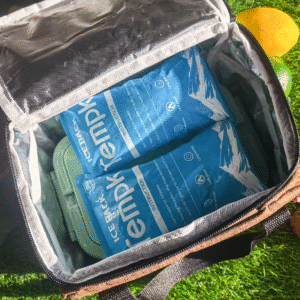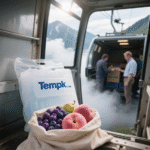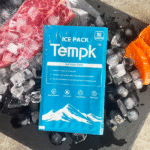كيفية التعامل مع عبوات الثلج الجاف بشكل آمن ومربح 2025
إذا قمت بشحن البضائع المجمدة, يجب عليك أن تعامل مع عبوات الثلج الجاف الطريق الصحيح. في غضون دقائق, الحجم الجيد ووضع العلامات يمكن أن يمنع التلف, مصاريف, وحوادث السلامة. يوضح لك هذا الدليل كيفية التعامل مع عبوات الثلج الجاف لحماية الهامش, تلبية قواعد UN1845, والحفاظ على سلامة الفرق — من خلال نطاقات عملية, مقدرين سريعين, وطبقات التعبئة التي يمكنك استخدامها اليوم. ستحصل على خطوات باللغة الإنجليزية البسيطة تقلل المخاطر دون إبطاء العمليات.
-
طرق التعبئة والتغليف الأكثر أمانًا تعامل مع عبوات الثلج الجاف لموثوقية الشحن المجمدة
-
قواعد التحجيم السريع ومقدر يعتمد على المسار تعامل مع عبوات الثلج الجاف بدقة
-
2025 أساسيات التسمية والأوراق UN1845 عند تعامل مع عبوات الثلج الجاف
-
متى يتم التبديل من الثلج الجاف إلى PCM أو الجل لخفض التكاليف وثاني أكسيد الكربون
كيف يجب أن تتعامل مع عبوات الثلج الجاف للشحن المجمد?
ضع الجليد الجاف في الأعلى, تهوية الصندوق, واحتفظ بالقفازات - فهذه هي أسرع طريقة للحفاظ على درجات الحرارة المتجمدة الصلبة مع تجنب مشكلات ضغط ثاني أكسيد الكربون. في معظم شركات الشحن الصغيرة, الخسارة اليومية تمتد من 5 إلى 10 رطل; خطة كتلة كافية, توزيع الحزم في الأعلى, ولا تغلق الغاز أبدًا. عندما تقوم بتوزيع عبوات الثلج الجاف لممرات التجارة الإلكترونية, أضف حاجزًا رفيعًا على جانب الغطاء وأغلق الجيوب الهوائية.
ابدأ بهدف بسيط: تبقى البضائع المجمدة ≥ -20 درجة مئوية من الرصيف إلى الباب. لأن ثاني أكسيد الكربون يغرق, يقوم الثلج الجاف الموجود فوق المنتج بدفع الهواء البارد نحو الأسفل. قم بتهوية القنوات الصغيرة حتى يتسرب الغاز المنبعث; لا تقم أبدًا بتحميل الجرار أو الأكياس محكمة الغلق. لمعظم الكميات سعة 20 لترًا, ستحتاج إلى ما يقرب من 1.5-2.5 كجم لكل قطعة 24 ساعات, ثم اضبط العزل والطقس. مخزن في معزول, مناطق جيدة التهوية - وليس المجمدات المغلقة - لإبطاء التسامي وحماية الموظفين. في الأشهر الحارة, التعامل مع عبوات الثلج الجاف عن طريق زيادة الكتلة وتحسين سمك الجدار على الممرات الطويلة.
الثلج الجاف مقابل الجل/PCM: الذي يحمي الميزانية والمنتج?
يحمل الثلج الجاف النطاق الأبرد (تصل إلى -78.5 درجة مئوية) للآيس كريم, اللحوم, والعينات السريرية. تعمل عبوات الجل على تثبيت درجة حرارة 0-5 درجة مئوية للمنتجات و2-8 درجة مئوية للمواد البيولوجية. يمكن لأجهزة PCM أن تستهدف -5 درجة مئوية, 0درجة مئوية, +5درجة مئوية, أو تتراوح درجة حرارة الغرفة لمدة تصل إلى 72 ساعات وتجنب الملصقات الخطرة. إذا كنت تتعامل مع عبوات الثلج الجاف للأطعمة الهشة, قم بإقرانها بحواجز الرطوبة لوقف حرق الفريزر.
| طريقة التبريد | درجة الحرارة الهدف | مدة نموذجية | ماذا يعني لك |
|---|---|---|---|
| حزم الثلج الجاف | ≥ -20 درجة مئوية إلى -78.5 درجة مئوية | 24-48 ح (أطول مع جدران أكثر سمكا) | تجميد سريع; يتطلب وضع العلامات والتهوية UN1845. |
| حزم هلام | -5 درجة مئوية إلى +5 درجة مئوية | 12-24 ساعة | جيد للبضائع المبردة; عوائد أبسط; لا خطر. |
| كتل PCM | مخصص (-25 درجة مئوية إلى +25 درجة مئوية) | حتى 72 ح | قابلة لإعادة الاستخدام; اختر درجة حرارة الطور التي تتوافق مع احتياجات المنتج. |
نصائح عملية
-
قبلك تعامل مع عبوات الثلج الجاف, قم بتجميد الحمولة مسبقًا حتى يبرد الجليد الشاحن, ليس المنتج.
-
ملء الفراغات; الهواء الفارغ يسرع الاحترار.
-
الحفاظ على الجليد الجاف في الأعلى; منتج أحواض وبطانيات ثاني أكسيد الكربون.
-
استخدام معزول, تخزين جيد التهوية; أبدا حاويات محكمة الإغلاق.
حالة حقيقية: تم نقل المختبر إلى طاولة ثابتة "الثلج الجاف في الساعة" والحزم المحملة من أعلى. ممرات اللقاح لمدة يومين تحمل ≥ -70 درجة مئوية 5 كجم الإجمالي, خفض أحداث الخسارة إلى الصفر.
كيف يمكنك تحديد حجم عبوات الثلج الجاف والتعامل معها حسب المسار?
استخدم مقدرًا سريعًا: ساعات العبور × 0.25 ≈ رطل من الثلج الجاف, ثم أضف 30% للممرات الساخنة و 20% للافتتاحات المخطط لها. التقريب إلى التالي 2 رطل لتتناسب مع أحجام العبوات الشائعة. التسامي اليومي النموذجي هو 5-10 رطل في مبرد قياسي, لذا فإن المسار الذي يستغرق 36 ساعة غالبًا ما يحتاج إلى حوالي 9-12 رطلاً. قم بتوثيق كيفية توزيع عبوات الثلج الجاف حتى تكرر فرق التعبئة الانتصارات.
اجعلها بسيطة وقابلة للتكرار. قم بتجميد المنتج مسبقًا, تقليل الفجوات الهوائية, والعزل المناسب الحجم. للحمولات سعة 20 لترًا, خط الأساس 1.5-2.5 كجم لكل 24 ساعات تعمل بشكل جيد; تتطلب الممرات الأطول أو الجدران الرقيقة المزيد. قم بتقسيم الثلج الجاف إلى عدة عبوات لتجنب الزوايا الساخنة ووضعها فوق الحمل حتى يكون باردًا. عندما تقوم بتوزيع عبوات الثلج الجاف على نطاق واسع, انشر جداول الممرات وأضفها إلى إجراءات التشغيل المعيارية (SOP) حتى يتمكن المبتدئون من فهمها بشكل صحيح في اليوم الأول.
| سيناريو لين | حجم الشاحن | شرق . الثلج الجاف | لماذا يعمل |
|---|---|---|---|
| 24 ح مترو, صيف | رغوة صغيرة, 1– 2 في الجدران | 8-10 رطل | يغطي الخسارة اليومية بالهامش. |
| 48 ح الإقليمية | يوريتان متوسط, 2 في الجدران | 18-22 رطل | تعمل الجدران السميكة على تمديد وقت الانتظار. |
| 72 ح عن بعد | ربحية السهم المؤهلة, 2.5 في الجدران | 26-30 رطل | كتلة أعلى + عازلة العزل. |
كيف تقوم بتسمية عبوات الثلج الجاف والتعامل بها بموجب رقم UN1845؟?
ضع علامة على وجه واحد بكلمة "UN 1845, الجليد الجاف, صافي × كجم,"أضف الفصل 9 الماس, واحتفظ بتفاصيل الشاحن/المرسل إليه بعيدًا عن ملصق المخاطر. عندما يقوم الثلج الجاف بتبريد البضائع غير الخطرة فقط, تتخطى معظم شركات النقل إعلان DG Shipper الكامل - لكن العلامات والوزن الدقيق لا تزال إلزامية. قم بتدريب الفرق على التعامل مع عبوات الثلج الجاف والملصقات معًا كقائمة مرجعية واحدة.
تختلف قواعد البريد والتكامل. نحن. يحد الهواء البريدي عمومًا من الثلج الجاف 5 رطل لكل طرد ويمنع البريد الدولي. تنشر شركات النقل قوائم مراجعة القبول, بما في ذلك حجم الملصق وموضعه. قم بإعادة وزنها قبل المناقصة مباشرةً، لذلك تم وضع الملصق عليها صافي كجم يطابق ما تبقى بعد أي عملية تسامي مسبقة التعبئة. إذا كنت تتعامل بشكل روتيني مع عبوات الثلج الجاف مقابل المرتجعات, قم بطباعة الملصقات مسبقًا وأضف الفراغات الصافية بالكيلو جرام.
متى يجب عليك توزيع عبوات الثلج الجاف أو التبديل إلى PCM?
قم بالتبديل عندما يكون النطاق الآمن ≥ −5 درجة مئوية أو 0 درجة مئوية والعبور ≥ 72 ساعات; احتفظ بالثلج الجاف للحصول على نتائج مجمدة صلبة. تتجنب أجهزة PCM التعامل مع المواد الخطرة, تقليل العوائد, ويمكن إعادة استخدامها. غالبًا ما تنخفض تكلفة الهبوط الإجمالية حتى لو كان سعر العبوة أعلى. إذا كنت لا تزال تتعامل مع عبوات الثلج الجاف على هذه الممرات, من المحتمل أنك تبالغ في الإنفاق.
اختر درجات حرارة الطور التي تتوافق مع منتجك: -5 درجة مئوية للتجميد الناعم, +5درجة مئوية للبيولوجيا 2-8 درجة مئوية, +18-25 درجة مئوية للوقاية من الحرارة في الصيف. أضف طبقة PCM رقيقة بدرجة حرارة 0 درجة مئوية أسفل الغطاء كمخزن مؤقت للتأخير حتى عند استخدام الثلج الجاف. تتبع العوائد وقم ببناء حلقة إعادة استخدام بسيطة للحصول على المدخرات وتقليل الهدر. قم بالتوثيق عندما لا يتم التعامل مع عبوات الثلج الجاف حتى يختار المشترون PCM تلقائيًا للممرات المناسبة.
التقييم الذاتي السريع: الثلج الجاف أو PCM?
إجابة نعم / لا. إذا سجلت 3+ نعم, اختر PCM/جل; خلاف ذلك, استخدم الثلج الجاف.
-
هل منتجك آمن عند درجة حرارة ≥ -5 درجة مئوية?
-
هل تقومون بشحن الممرات تحت 72 ساعات مع تأخيرات متكررة في الميل الأخير?
-
هل تستخدم البريد الجوي أو البريد العابر للحدود الذي يكره المواد الخطرة?
-
هل يمكنك استعادة وإعادة استخدام الحزم في الوجهة؟?
-
هل تريد ملصقات أبسط وعددًا أقل من الطرود المرفوضة؟?
كيف تحافظ على سلامة الفرق عند توزيع عبوات الثلج الجاف?
الهدف CO₂ ≥ 5,000 جزء في المليون (8- متوسط الساعة) و ≥ 30,000 جزء في المليون لرشقات نارية قصيرة; استخدم عادمًا منخفض المستوى ولا تركب أبدًا مع الصناديق في كبائن مغلقة. ارتداء القفازات الحرارية أو الجلدية, تجنب حاويات محكمة الإغلاق, وتهوية مناطق التدريج. عندما تقوم بتوزيع عبوات الثلج الجاف في شاحنات صغيرة أو في أماكن قريبة, مراقبة ثاني أكسيد الكربون عند ارتفاع التنفس.
يمكن للغاز المنبعث أن يحل محل الأكسجين بسرعة في الشاحنات, المشي, أو غرف صغيرة. تشقق الأبواب أثناء التحميل, أضف شاشات بسيطة مزودة بأجهزة إنذار تقترب من 5000-8000 جزء في المليون, وتدريب الطاقم على حزم التحميل العلوي. تخزين الصناديق في مكان بارد, مناطق جيدة التهوية وتجنب الطوابق السفلية أو كبائن المركبات حيث يمكن أن يتجمع الغاز. أضف عبارة "صفقة عبوات الثلج الجاف" لتجديد المعلومات عند الانضمام حتى تلتصق العادات الجيدة.
2025 الاتجاهات التي تشكل كيفية التعامل مع عبوات الثلج الجاف
تستمر الاستدامة والقياس عن بعد في إعادة تشكيل تخطيط سلسلة التبريد في 2025. أجهزة PCM قابلة لإعادة الاستخدام, أفلام قابلة لإعادة التدوير, وتتحرك تنبؤات المسار والتسامي القائمة على الذكاء الاصطناعي في الاتجاه السائد. توقع ضمان جودة أكثر صرامة لدى شركات النقل وطلبًا أكثر ثباتًا مع توسع التجارة الإلكترونية في الأغذية وعلوم الحياة. الفرق ذلك تعامل مع عبوات الثلج الجاف مع إجراءات التشغيل الموحدة والآلات الحاسبة، يمكنك رؤية عدد أقل من الطرود المرفوضة.
ما الجديد في لمحة
-
تسمية أسرع لضمان الجودة: قامت شركات النقل بتشديد الطباعة وقوائم مراجعة القبول; أضف فحصًا لملصق العبوة.
-
أصبحت سلامة ثاني أكسيد الكربون أمرًا سهلاً: تعمل أجهزة المراقبة ذات الأسعار المعقولة على تبسيط عملية التدريب وفحص منطقة التدريج.
-
نمو PCM: تعمل برامج إعادة الاستخدام على تقليل نقاط الاتصال الخطرة ورفض الميل الأخير.
نظرة السوق: الطلب على التسليم المجمدة والمبردة يتزايد بشكل مطرد. خطط للتقلبات الدورية في أسعار الثلج الجاف وفكر في العبوات الهجينة التي تمزج PCM مع الثلج الجاف للتحوط من التأخير. إذا كنت حاليا تعامل مع عبوات الثلج الجاف في كل حارة, الجزء حسب درجة الحرارة المطلوبة والتحول من 2 إلى 8 درجات مئوية إلى PCMs.
الأسئلة المتداولة
كم من الوقت تستمر عبوات الثلج الجافة?
خطط لمدة 24-48 ساعة حسب العزل والحمل; الخسارة اليومية عادة ما تكون 5-10 رطل. عندما تعامل مع عبوات الثلج الجاف, الحجم إلى أطول وقت عبور واقعي.
هل يمكنني إعادة استخدام كيس الثلج الجاف؟?
نعم، إذا كان الحاجز الخارجي سليمًا وغير ملوث; قم دائمًا بالفحص قبل إعادة الاستخدام. للفرق ذلك تعامل مع عبوات الثلج الجاف أسبوعي, إنشاء قائمة مرجعية بسيطة للنجاح/الفشل.
أين يجب أن توضع العبوات في الصندوق?
فوق الحمولة الصافية، تغرق البرودة فوق المنتج; انقسم إلى حزم متعددة لتجنب الزوايا الساخنة. تدريب الطواقم على تعامل مع عبوات الثلج الجاف باستمرار.
هل يمكنني وضع الثلج الجاف في بطانة أو برطمان مغلق؟?
لا. يمكن أن يؤدي الغاز المنبعث إلى زيادة الضغط وتمزق الحاويات. تنفيس قليلاً ولا تغلق الغاز أبدًا. ينطبق هذا في أي وقت تعامل مع عبوات الثلج الجاف.
هل أحتاج إلى إعلان المدير العام?
ليس عادةً عندما يقوم الثلج الجاف بتبريد المحتويات غير الخطرة فقط, لكن العلامات والكيلوغرامات الصافية مطلوبة. أضف هذا إلى "كيف نحن تعامل مع عبوات الثلج الجاف"SOP.
ملخص وتوصيات
للتعامل مع عبوات الثلج الجاف بشكل جيد, التحميل العلوي والتهوية, الحجم الصحيح حسب المسار, تسمية UN1845 مع صافي كجم, وقم بالتبديل إلى PCMs عندما يسمح النطاق الآمن بذلك. قم بنشر جداول التعبئة للفرق تعامل مع عبوات الثلج الجاف بنفس الطريقة في كل مرة.
الخطوات التالية: قم بتشغيل المقدر السريع على الممرات الثلاثة الأولى لديك, قم بإضافة علامة ضمان الجودة (QA) عند التعبئة, وتجريب حلقة إعادة استخدام PCM للمنتجات التي تتراوح درجة حرارتها بين 2 و8 درجات مئوية. إذا كنت لا تزال تعامل مع عبوات الثلج الجاف على تلك الممرات البيولوجية, اختبر بديل PCM هذا الأسبوع.
حول Tempk
نحن نصمم حزم سلسلة تبريد عملية وإجراءات تشغيلية موحدة لشركات شحن المواد الغذائية وعلوم الحياة. مهندسونا مؤهلون للتغليف, تحسين الحزم, وبناء الآلات الحاسبة حارة التي تساعدك تعامل مع عبوات الثلج الجاف أو قم بالتبديل إلى أجهزة PCM بثقة. اثنين من نقاط القوة: جداول التعبئة التي تم التحقق من صحتها وسير عمل ضمان الجودة السريع. تحدث إلينا لقياس مساراتك وتعزيز موثوقية التسليم المجمد.
























